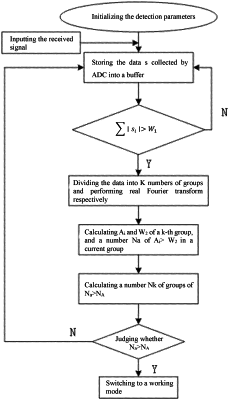| CPC H04L 27/2614 (2013.01) [H04B 13/00 (2013.01); H04L 27/265 (2013.01)] | 3 Claims |

|
1. A low-computation underwater acoustic wake-up method based on a multi-carrier signal, comprising:
step S1: generating the multi-carrier signal at a transmitter, comprising:
step S101: obtaining a frequency band of the multi-carrier signal and parameters required for a receiver detecting the multi-carrier signal, wherein the parameters comprise a sampling rate of a single-chip microcomputer, a data buffer size N when the receiver receives the multi-carrier signal, the group number K of N numbers of elements, a time-domain threshold, a threshold of a number of amplitudes of wake-up frequency points in a current group being greater than a frequency-domain threshold, and a wake-up threshold; and K is a positive integer, N is a positive integer;
step S102: calculating frequency points to be selected according to the obtained parameters, and selecting the wake-up frequency points from the frequency points to be selected as frequencies carried by the multi-carrier signal;
step S103: determining a duration of the multi-carrier signal;
step S104: shifting phases of the wake-up frequency points to generate the multi-carrier signal with a minimum peak to average power ratio (PAPR); storing the generated multi-carrier signal at the transmitter and transmitting the multi-carrier signal for waking up the receiver;
step S2: detecting the multi-carrier signal at the receiver, comprising:
step S201: passing the multi-carrier signal received by the receiver through an energy transducer and then through an amplifier circuit and an analog-to-digital converter, to convert the received multi-carrier signal in analog form into a digital signal, and obtain data of the multi-carrier signal after the conversion of analog-to-digital;
step S202: setting the parameters in the step S101;
step S203: storing the data of the multi-carrier signal in a first buffer with a window length N in real time, to obtain buffered data;
step S204: setting a timer for triggering detecting of the multi-carrier signal received by the receiver at a certain time interval, and re-storing the buffered data in a second buffer with a same window length during the detecting;
step S205: taking absolute values of elements in the second buffer and summing the absolute values to obtain a sum;
step S206: comparing the sum with the time-domain threshold, entering step S207 when the sum is greater than the time-domain threshold; or returning to the step S204 and waiting for the timer to trigger again when the sum is not greater than the time-domain threshold;
step S207: dividing the N number of elements into K number of groups, with N/K number of elements in each of the K number of groups, and obtaining the number of the amplitudes of the wake-up frequency points in each of the K number of groups being greater than the frequency-domain threshold by performing steps S208 through S211 for each of the K number of groups:
step S208: performing real Fourier transform on the elements in the current group to obtain amplitudes of N/2K frequency points;
step S209: selecting the amplitudes respectively corresponding to the wake-up frequency points from the amplitudes, and selecting amplitudes of frequency points between the wake-up frequency points from the amplitudes as reference amplitudes;
step S210: weighting the reference amplitudes to obtain the frequency-domain threshold;
step S211: comparing each of the amplitudes of the wake-up frequency points with the frequency-domain threshold to obtain the number of the amplitudes of the wake-up frequency points greater than the frequency-domain threshold; and
step S212: comparing the number of each of the K number of groups with the threshold of the number of amplitudes of wake-up frequency points in the current group being greater than the frequency-domain threshold, and recording that a number of groups with the number greater than the threshold of the number of amplitudes of wake-up frequency points in the current group being greater than the frequency-domain threshold; turning on a power supply of a rear-end circuit when the number of groups is greater than the wake-up threshold, or returning to the step S204 when the number of groups is not greater than the wake-up threshold.
|